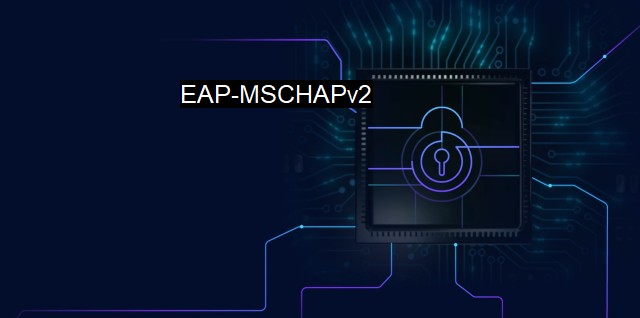What is EAP-MSCHAPv2?
EAP-MSCHAPv2: A Highly Secure Data Encryption Tool for Contemporary Cybersecurity
EAP-MSCHAPv2 is a protocol that stands for Extensible Authentication Protocol Microsoft's Challenge Handshake Authentication Protocol version 2. This protocol stems from the networking realm, particularly focused on allowing client-server data security interactions, with a common application in wireless networks. Its significance and relevance cannot be overstated, especially within the context of cybersecurity and antivirus solutions where securing connections is of paramount importance.Cybersecurity pertains to all measures and systems put in place to protect data, systems, and networks from cyber-attacks, unauthorized access, damage, or theft. As data movement grows at an exponential rate in today's interconnected world, stringent cybersecurity mechanisms like encrypted communications have become vital. Similarly, antivirus solutions are software designed to detect, prevent, and eliminate malicious software such as viruses, malware, ransomware, etc.
The role of protocols like EAP-MSCHAPv2 comes into play here, as they provide the necessary encrypted communications in data networks to prevent any unauthorized access to the data. These encrypted communication pathways are essentially the pathways over which data flows from one computer to another. They are a series of instructions or set rules that govern how data transfers occur over the network. Without such protocols, the networks would have no organized or secure way to handle data movement, making it highly vulnerable to cyber attacks.
EAP-MSCHAPv2 is an encapsulate authentication protocol that provides mutual authentication between any Points of Presence (POPs) and network users - typically on remote servers. This protocol has a three-step process to verify and authenticate digital credentials. The access point initially sends an identity request to the client, which responds by storing the credentials for future use and sharing a username. Then, Nash Challenge from the access point to the client - containing a session-specific challenge. The client machine hashes this challenge with the user's password in order to create a response and make a mutual authentication of their experience possible.
Integral to EAP-MSChapv2 performance is the comprehensive protection of user login credentials. This is actually one of the main advantages and reasons for utilizing EAP-MSChapV2 in networking practices. By implementing sophisticated cryptography and complex data encryption for identifier exchange between the server and client, it manages to ward off invading hackers attempting to steal data. Antivirus solutions can work hand-in-hand with this protocol, checking the system for any security lapses or suspicious activity, stopping any potential breakthrough from harmful elements.
While EAP-MSCHAPv2 has made important strides in security provisions, there are some known vulnerabilities. These weaknesses often arise due to certain complexities in its cryptographic protection systems, and perpetrators can exploit them to gain unauthorized access or intercept sensitive information. Therefore, appropriately combined with antivirus solutions and regular cyber safety audits, operators can maintain it as a definite advantage when it comes to securing their networks from cyber crimes.
Proper use of such protocols requires substantial knowledge and understanding. Network administrators must have competencies regarding configuration settings, parameters, and other technical factors, as incorrectly secured EAP could lead to severe security breaches that even antivirus solutions might fail to block promptly. Therefore, it is vital for network administrators to partake in continuous learning and education in order to keep pace with evolving cyber threats and the development of potential countermeasures.
EAP-MSCHAPv2 is a crucial protocol in the domain of cybersecurity. Helping to establish and maintain secure connections, it acts as a strong frontline defense against data breaches and attacks. staying mindful of its vulnerabilities and employing additional antivirus measures further strengthens a network's protection level. Therefore, for anyone dealing with network data, understanding the exposé on EAP-MSCHAPv2 and maintaining a level of cybersecurity-awareness is truly essential in today's increasingly digital world.

EAP-MSCHAPv2 FAQs
What is EAP-MSCHAPv2?
EAP-MSCHAPv2 is a widely used authentication protocol in cybersecurity that enables users to securely authenticate their identity when accessing a network or system. It is commonly used in antivirus programs to authenticate the user and provide access to the system.How does EAP-MSCHAPv2 work?
EAP-MSCHAPv2 uses an encryption algorithm to securely transmit the user's credentials to the server. The server then verifies the user's identity before granting access to the network or system. It provides a secure connection between the user's device and the network, ensuring that the user's data is protected from unauthorized access.What are the benefits of using EAP-MSCHAPv2?
The main benefit of using EAP-MSCHAPv2 is that it provides a secure way for users to authenticate their identity and access the network. It uses high-level encryption protocols to ensure that the user's data remains confidential and protected from cyber threats. It is also easy to use and can be integrated with many different systems and devices.Is EAP-MSCHAPv2 vulnerable to cyber attacks?
Although EAP-MSCHAPv2 is considered a secure authentication protocol, it has been found to be vulnerable to some types of cyber attacks in certain scenarios. For example, it may be vulnerable to attacks that exploit flaws in the encryption protocol or use social engineering techniques to trick users into providing their login credentials. However, there are measures that can be taken to mitigate these risks, such as using strong authentication methods and implementing security protocols that are resistant to attacks.| | A | | | B | | | C | | | D | | | E | | | F | | | G | | | H | | | I | | | J | | | K | | | L | | | M | |
| | N | | | O | | | P | | | Q | | | R | | | S | | | T | | | U | | | V | | | W | | | X | | | Y | | | Z | |
| | 1 | | | 2 | | | 3 | | | 4 | | | 7 | | | 8 | | |||||||